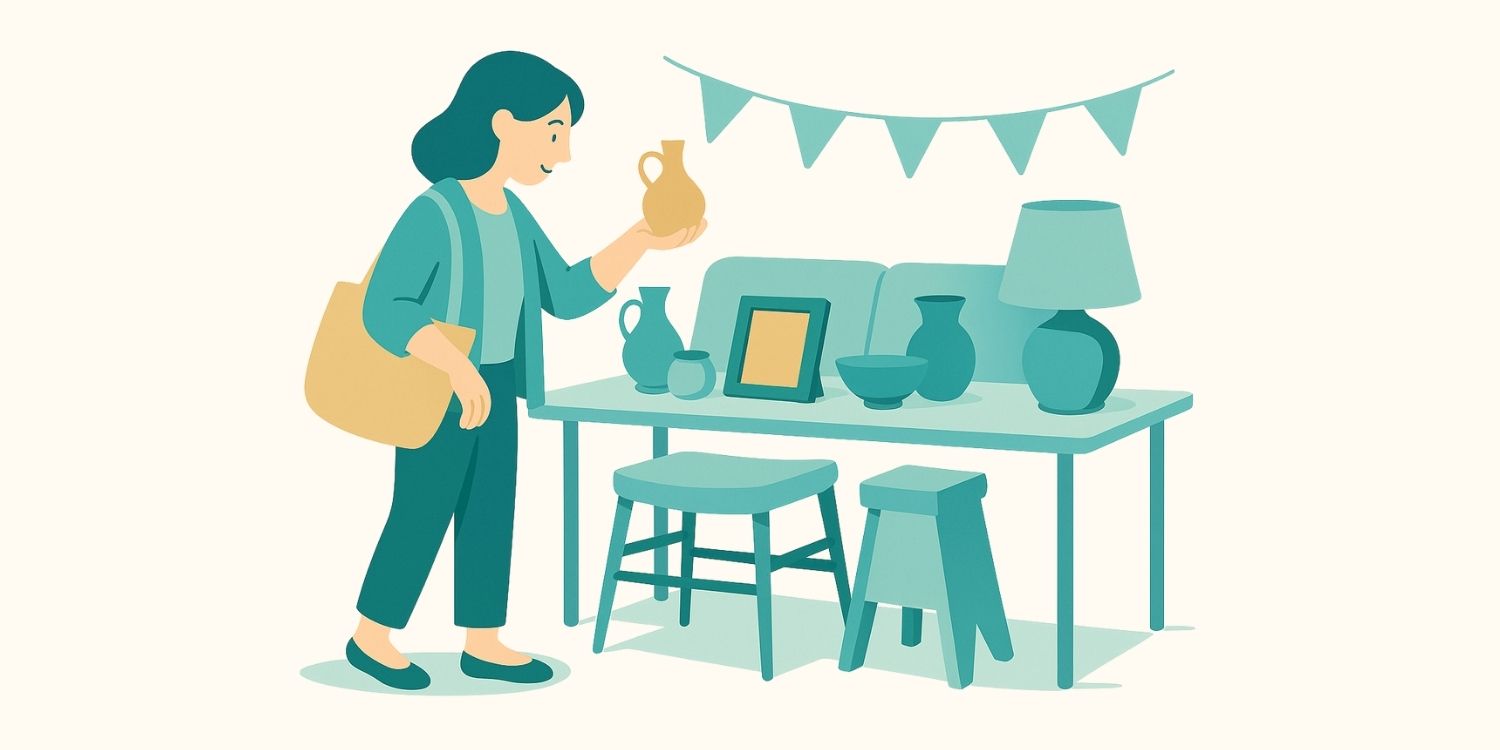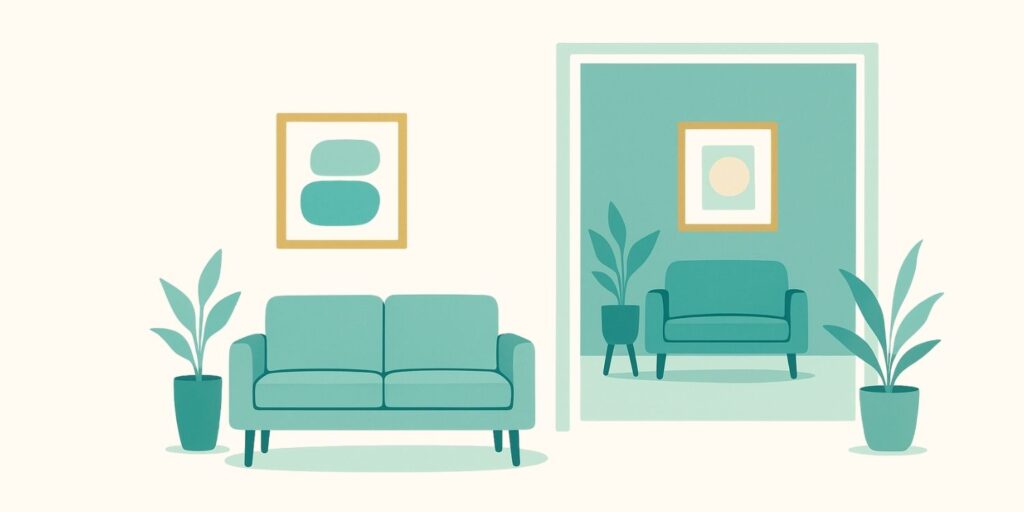by Eric Hod | Design Manager, Hudson’s Furniture
A Guide to Finding Your Own Unique Aesthetic
Picture yourself walking into your dream space with no limitations. What do you see? Notice the colors that surround you. Feel the textures under your fingertips. Watch how the light moves through the room. Pay attention to the way each detail makes you feel.
That vision you just imagined? That feeling? That’s the foundation of your personal design style.
Creating a space that feels authentic requires understanding yourself, trusting your instincts, and learning how to translate your vision into reality. It means choosing colors that calm you, textures that invite you to touch them, and furniture that makes sense for how you actually live. This guide will show you exactly how to discover and develop your unique design style, from building mood boards to mixing different eras, avoiding common mistakes, and making smart budget decisions that bring your vision to life.
Jump to what you want to know:
- What is personal design style & why does it matter?
- How to identify your design style
- How to build a design mood board
- How to mix different design styles
- Common design style mistakes & how to avoid them
- Room size guidelines for common furniture
- How to work with professional interior designers
- Budget-friendly tips to help define your design style
- How to create design style consistency throughout your home
- Frequently Asked Questions
What Is Personal Design Style & Why Does It Matter?
Design style isn’t about memorizing French terms or knowing the difference between Bauhaus and Art Deco. Your personal style is the visual language that makes you feel at home. It’s the collection of colors, textures, shapes, and objects that resonate with your personality and lifestyle.
Research from the Newport Institute shows that our environment significantly impacts our mood, productivity, and overall well-being. When you live in a space that reflects your authentic style, you feel more comfortable, creative, and content. You’re not performing for guests or following someone else’s rulebook. You’re simply being yourself.
Think about the homes that stick in your memory. Your grandmother’s cozy kitchen with mismatched china. Your best friend’s minimalist loft with one perfect plant. These spaces work because they’re genuine. They tell a story. Your design style should do the same.

How to Identify Your Design Style
Interior design magazines love to categorize everything. Mid-century modern. Boho chic. Scandinavian minimalism. Coastal farmhouse. These labels help us communicate genres of style, but they can also limit us to picking a single lane. Don’t let a style label become a cage. Instead, start with how you want to feel in your space.
Ask yourself these questions:
- Do you want to feel energized when you wake up, or calm and centered?
- Does your ideal evening involve curling up in a cozy cocoon or hosting friends in an open, airy space?
- Do you crave visual stimulation or visual rest?
- Does clutter stress you out, or does it make you feel surrounded by things you love?
- Do you want your home to feel like a gallery, a sanctuary, or a playground?
Your answers to these questions matter more than any style label. Environmental psychologists have found that design elements like color, lighting, and spatial arrangement directly affect our emotional state. A room that makes you feel the way you want to feel is already halfway to success.
Let’s say you want to feel peaceful and grounded. You might gravitate toward natural materials like wood and stone. Soft, neutral colors. Simple, clean lines. Open space that lets you breathe. You’re not necessarily “going for” Japanese minimalism or Scandinavian design. You’re choosing elements that support the feeling you want.
On the other hand, if you want to feel inspired and energized, you might choose bold colors, varied textures, and eclectic collections. Artwork that makes you think. Books everywhere. Layers of pattern and interest. This isn’t just maximalism for its own sake. It’s creating an environment that feeds your creative energy.
The feeling comes first. The style follows.
How to Build a Design Mood Board
Once you’ve identified how you want to feel, start collecting visual inspiration. This step reveals patterns you might not consciously recognize, thus bringing to the surface your design DNA. You can build mood boards in one of two ways:
#1 – Digital mood boards: Using platforms like Pinterest or apps like Milanote, you can easily save digital images. You don’t have to make your board public. Instead, create a private board called “My Design Style” and start pinning without overthinking it.
#2 – Physical mood boards: Tear pages from magazines. Print photos from your travels. Tack fabric swatches to poster or cork boards. Don’t filter yourself and simply collect items that resonate: a photo room you love, a color sample card for the hardware store, a flower from a garden, even an outfit that captures a vibe.
This technique, simply called “moodboarding,” is often used by professional designers because it taps into their clients’ subconscious preferences. Because this exercise does not require people to definitively declare allegiance to one specific style, it reduces creative barriers in the brainstorming process.
Once you’ve collected 30 to 50 images, the real magic can begin. Observing your style inclinations at a top level, you can start to see patterns. Patterns in themes, or colors, or even mood. These patterns aren’t random. They’re clues to what genuinely resonates with you, allowing you to find furniture and decor that connect with your style.
Your mood board can also become a visual filter, helping you to check whether a piece you’re intrigued by aligns with these patterns or perhaps is an impulse or trendy purchase that won’t fit long-term.

How to Mix Different Design Styles
Here’s the truth that design magazines don’t always tell you: most beautiful homes mix styles. Sticking rigidly to one aesthetic rarely feels like home. Pure Victorian feels like a museum. All modern feels cold and sterile. Wall-to-wall farmhouse reads like a staged Airbnb. Industrial everything can feel like you’re living in a warehouse. Even Scandinavian minimalism, beautiful as it is, can feel too sparse and clinical when taken to extremes.
Real homes layer different periods, aesthetics, and influences.
Think about it. You didn’t collect everything in your life from one era or one store. That vintage mirror your grandmother gave you tells a story. The sleek dining table you saved for represents a milestone. The colorful pillows from your travels spark joy every time you see them. Your home should honor all these pieces of your life, not force them into a single category.
When you walk into a home that mixes styles successfully, it feels collected, not decorated. It suggests depth, curiosity, and a life well-lived. These spaces have character because they’re authentic. They show someone who trusts their own taste enough to break the rules.
The key isn’t whether you mix styles. It’s how you mix them. Done thoughtfully, eclecticism creates richness and visual interest. Done randomly, it creates chaos. The difference comes down to intention.
So how do you mix with intention? Four fundamental principles create harmony even when your pieces come from completely different worlds.
Principle #1: Use Color as Your Unifying Thread
Color theory shows that a cohesive palette ties disparate elements together. You can combine a rustic farmhouse dining table with modern acrylic chairs if they share similar tones. The wood might be warm walnut, the chairs clear or smoke-tinted. The warmth connects them.
Choose a color palette of three to five colors that you’ll repeat throughout your space. This doesn’t mean everything matches. It means there’s a thread running through the room that creates visual harmony.
When every piece in your room relates to this palette, even wildly different styles can coexist peacefully.
Principle #2: Blend Different Furniture Eras for Depth
Mixing furniture from different time periods creates layers of interest that single-era rooms can’t achieve. A vintage wooden dining table gains new life paired with contemporary upholstered dining chairs. A modern sectional sofa looks more interesting flanked by antique side tables.
The contrast tells a story about how you collected your home over time. It suggests you’re someone with varied interests, not someone who bought everything from one showroom catalog in one afternoon..
Interior designers call this technique “high-low mixing,” and it’s one of the most effective ways to create sophisticated spaces.
Principle #3: Let Texture Do the Heavy Lifting
Texture might be the most underestimated tool in design. When you combine different textures, you create tactile interest that makes a space feel rich and inviting, even if your color palette is simple.
Try layering:
- Smooth leather with nubby linen
- Glossy ceramic with rough-hewn wood
- Polished metal with soft velvet
- Cool marble with warm wool
These combinations give your eye something to explore. They make a space feel intentionally curated rather than accidentally assembled. When shopping for accent chairs or upholstered pieces, consider how their texture will complement or contrast with your existing furniture.
Principle #4: Create Intentional Echoes Throughout Your Space
Repeat certain elements throughout your space to create cohesion. Think of repetition as the invisible thread that ties your room together. When the same finish appears on your cabinet hardware and your picture frames, your brain registers a connection even if the pieces themselves are completely different styles. These visual echoes whisper “this belongs here” without shouting “everything matches.”
This could be:
- A metal finish (brass hardware on cabinets echoed in light fixtures and mirror frames)
- A wood tone (matching the finish on your coffee table, bookshelf, and picture frames)
- A shape (round mirrors, round side tables, and rounded chair arms)
- A pattern (geometric tiles in the bathroom, geometric pillows in the bedroom)
Repetition doesn’t mean everything matches exactly. It means your space has intentional echoes that make it feel considered and complete.

The Most Common Design Style Mistakes & How to Avoid Them
You’ve done the work. You’ve created your mood board, identified your patterns, and learned how to mix styles with intention. But even with the best preparation, certain pitfalls can derail your design journey. The good news? These mistakes are predictable, which means they’re completely avoidable. Understanding what trips people up most often saves you time, money, and the frustration of living with choices that don’t feel right. Here are the five most common mistakes and exactly how to sidestep them.
Mistake #1: Buying Everything at Once From the Same Collection
We’ve all felt the excitement of moving into a new space. Everything’s empty. The possibilities feel endless. And right there in the showroom sits a perfectly coordinated collection that solves all your problems at once. The temptation to buy it all and be done is powerful. Resist it.
Buying everything in one shopping trip often leads to:
- Pieces that don’t actually fit your lifestyle once you live with them
- A space that feels curated by a store, not by you
- Rushed decisions you’ll regret
- A showroom look that lacks personality
Professional designers recommend living in your space for several weeks before making major purchases. Notice how light moves through the rooms. Where do you naturally want to sit? What activities happen in each space? Let these observations guide your purchases.
Mistake #2: Chasing Trends Instead of Style Building
Trends are intoxicating. They’re everywhere on social media, promising that one accent wall or furniture piece will transform your entire space. And they’re fun to follow. But here’s what design magazines don’t emphasize enough: trends have expiration dates.
Design trends typically last ten months before feeling dated, with some trends defying odds and living on for a few years. If you build your entire style around what’s currently popular, your home will feel outdated faster than your furniture wears out. You’ll spend more time and money constantly updating than you would have investing in timeless pieces from the start.
The solution isn’t to ignore trends completely. It’s to use them strategically in easily changed elements. That trendy coral pink works beautifully in throw pillows you can swap out in a couple of years. The same pink on every wall becomes an expensive commitment when the trend passes. Save the bold trend moves for accessories, artwork, and textiles. Build your foundation on pieces that transcend whatever’s hot right now.
Mistake #3: Ignoring Scale & Proportion in Your Space
Walk into any furniture showroom and everything looks perfectly proportioned. That’s because showrooms are designed with careful attention to scale. Your home is different. An oversized sectional that looked substantial in a 2,000 square foot showroom swallows your 300 square foot living room. Delicate accent chairs that seemed refined in the store disappear in your spacious great room.
Getting scale wrong doesn’t just create visual problems. It affects how your space functions and feels. Furniture that’s too large makes rooms feel cramped and hard to navigate. Furniture that’s too small makes rooms feel incomplete and awkward, like you’re living in temporary housing.
Before you buy anything substantial, measure your space carefully and create a rough floor plan with furniture dimensions. Consider not just whether furniture fits physically, but whether the proportions feel right for your room’s size and ceiling height.
Room Size Guidelines for Common Furniture
Use these guidelines to help you choose furniture that fits comfortably in your space while allowing easy movement and proper functionality.
| Furniture Piece | Minimum Room Size | Ideal Room Size |
|---|---|---|
| Living Room | ||
| Standard Sofa (84″) | 10′ x 12′ | 12′ x 16′ |
| Sectional Sofa | 12′ x 14′ | 14′ x 18′ |
| Loveseat (60″) | 8′ x 10′ | 10′ x 12′ |
| Accent Chair | 6′ x 8′ | 8′ x 10′ |
| Coffee Table | 10′ x 12′ | 12′ x 14′ |
| Bedroom | ||
| King Bed | 12′ x 12′ | 13′ x 13′ |
| Queen Bed | 10′ x 10′ | 10′ x 12′ |
| Full Bed | 9′ x 10′ | 10′ x 12′ |
| Twin Bed | 7′ x 10′ | 8′ x 10′ |
| Two Nightstands + King Bed | 13′ x 13′ | 14′ x 16′ |
| Dresser | 10′ x 10′ | 11′ x 12′ |
| Dining Room | ||
| 4-Person Table (Round/Square) | 9′ x 9′ | 10′ x 10′ |
| 6-Person Table (Rectangular) | 10′ x 12′ | 11′ x 14′ |
| 8-Person Table (Rectangular) | 11′ x 14′ | 12′ x 16′ |
| 10-Person Table (Rectangular) | 12′ x 16′ | 14′ x 18′ |
| Home Office | ||
| Standard Desk (60″) | 8′ x 8′ | 10′ x 10′ |
| L-Shaped Desk | 9′ x 9′ | 10′ x 12′ |
| Executive Desk | 10′ x 10′ | 12′ x 14′ |
| Bookcase (Standard) | 6′ x 8′ | 8′ x 10′ |
Mistake #4: Choosing Looks Over Livability
Your home needs to work for your actual life, not your aspirational life.
That white linen sofa is stunning. The glass coffee table is a work of art. The velvet chair photographs beautifully. But if you have a habit of eating dinner on the couch, that white linen sofa is setting you up for stress, not relaxation. If you have kids, that glass coffee table with sharp edges could mean stitches. And, if you work from home, you need a real desk chair with proper ergonomics, not just a pretty office setup whose photos will get likes on IG.
The most successful interiors balance beauty with livability. Style should enhance function, not fight against it. When browsing living room furniture, consider performance fabrics and durable construction alongside aesthetic appeal. Ask yourself how each piece will hold up to your daily routine, not just how it looks in perfect lighting.
Mistake #5: Neglecting Lighting Design
People spend weeks choosing the perfect sofa, agonizing over paint colors, and hunting for the ideal rug. Then they stick with the builder-grade light fixtures that came with the house. This is backwards. Lighting transforms everything.
Research shows lighting design affects not just visibility but mood, color perception, and even our circadian rhythms. The wrong lighting makes even beautiful furniture look flat and uninviting. The right lighting makes modest pieces look expensive and creates an atmosphere that no amount of furniture can achieve alone.
Layer your lighting in three ways:
- Ambient lighting: Overall illumination from ceiling fixtures that fills the entire room
- Task lighting: Focused light for specific activities like reading lamps, under-cabinet lights, or desk lamps
- Accent lighting: Decorative lighting that highlights artwork, architectural features, or creates mood
Dimmers give you control over mood and intensity throughout the day. They’re one of the best investments you can make in your space, transforming one room into multiple moods depending on the time and activity.

How to Work With Professional Interior Designers
Creating your personal style doesn’t mean you have to do everything alone. Even the most design-savvy homeowners reach a point where a second set of expert eyes makes all the difference. Professional designers bring experience, perspective, and access to resources that help you turn ideas into a cohesive reality without costly missteps or endless second-guessing.
When Should You Consider Professional Design Help?
There’s a common misconception that working with a designer means surrendering creative control. In truth, the best designers amplify your vision. You might benefit from professional guidance if you:
- Feel overwhelmed by endless choices and don’t know where to start
- Have a tricky space with awkward proportions, unusual architecture, or poor lighting
- Want to finish your project efficiently instead of stretching it over months or years
- Need help translating a Pinterest board into something livable and uniquely yours
- Want access to trade-only resources, exclusive pieces, and better pricing
A good designer acts as a guide, not a dictator. They help refine your taste, edit your options, and make sure every piece works together beautifully.
What to Expect From Hudson’s In-Home Design Services
At Hudson’s Furniture, our complimentary in-home design service brings professional expertise directly to you. The process is simple and surprisingly personal.
Your personal Hudson’s Designer will:
- Visit your home to assess dimensions, lighting, and layout flow
- Listen closely to your lifestyle needs and aesthetic preferences
- Identify which pieces to keep, refresh, or replace
- Develop a cohesive plan that captures your personality and works for your budget
From there, we’ll show you curated furniture options that align with your vision and space. It’s a relaxed, collaborative process, one that takes the guesswork out of design decisions and helps you feel confident before you buy.
Want a head start? Take our Design Style Quiz online to discover your signature aesthetic before your consultation.

Questions to Ask Any Interior Designer
Working with a professional should feel empowering, not intimidating. The best partnerships start with clear communication and mutual understanding. Before committing to a designer, take time to ask thoughtful questions about their process, experience, and approach. These conversations reveal whether your personalities and design philosophies align, and that alignment is often the difference between a smooth, inspiring collaboration and one that feels off-course.
Use these questions to guide your first conversation:
- How do you identify and translate a client’s personal style?
- Can you work within my budget and timeline?
- What does your process look like from concept to completion?
- How many revision rounds are included in your service?
- Do you handle furniture sourcing, or will I shop independently?
- What’s your policy if I don’t love something once it arrives?
Keep in mind, a great designer listens more than they talk. They’re there to bring your vision to life, not impose their own style on your home.

Budget-Friendly Tips to Help Define Your Design Style
Creating a home that feels personal and polished doesn’t have to mean spending endlessly. Great design comes from thoughtful choices, not limitless budgets. When you combine a few quality investments with creativity and patience, you can build a space that looks curated, not costly.
Tip #1: Invest in Quality, Not Quantity
One well-made piece that truly represents your style will always outshine five that almost work. Think of these as your anchor pieces or the foundation of your room’s design. Sofas, dining tables, and beds should be built to last, both structurally and stylistically. Once those key investments are in place, layer in affordable accents to round out the look.
The goal isn’t to fill your home quickly. It’s to fill it intentionally. A beautiful, well-built piece you’ll love for a decade is more cost-effective than replacing lower-quality furniture every few years.
When you’re ready to invest in those anchors, explore our curated bedroom furniture collections and dining room sets, pieces designed to balance craftsmanship, comfort, and timeless style within a practical budget.
Tip #2: Shop Secondhand for Character-Rich Accents
Not every great design moment starts in a showroom. Some of the most charming, personality-filled accents come from places like estate sales and consignment shops. Secondhand finds bring texture, history, and warmth qualities that make your space feel truly lived in, not just styled.
Instead of hunting for large furniture pieces, focus on smaller decorative accents that layer depth and character into your home:
- Stacks of hardback books to style on coffee tables or shelves
- Brass candlesticks or sculptural candle holders
- Trays for corralling remotes, coasters, or barware
- Unique glassware and bar accessories
- Ceramic or terracotta pots for plants or storage
- Vintage picture frames or small artwork
These small details are where secondhand shopping shines. You can experiment, mix eras, and add personality without big commitments or big costs.
Blend your one-of-a-kind vintage accents with new furniture, and you’ll create a look that feels layered and collected over time. The mix of fresh craftsmanship and storied character is what transforms a space from beautiful to unforgettable.
Tip #3: Use DIY Projects to Add Personality on a Budget
Not every design upgrade requires professional help or a large budget. Some of the most rewarding updates are the ones you do yourself:
- Painting walls, doors, or accent furniture
- Swapping cabinet hardware or light fixtures
- Installing peel-and-stick wallpaper or simple shelving
- Hanging artwork, mirrors, or gallery walls
- Sewing or customizing curtains and pillow covers
Save professional help for where it counts, major furniture purchases, structural changes, or complex electrical work. Think of DIY as your creative outlet between those investment buys. The small touches you add by hand give your professionally designed spaces warmth and authenticity.

Tip #4: Transform Your Space With Paint
Few tools offer a bigger visual impact for the price than paint. For a few hundred dollars, you can completely change the mood of a room. Better Homes & Gardens reports that paint offers the highest return on investment for home updates.
Don’t stop at the walls. Paint a dresser to give it new life. Add color to the ceiling for soft sophistication. Try painting the back of a bookcase for an unexpected accent. Paint ties old and new together, making an inherited table or thrifted find feel intentional.
How to Create Design Style Consistency Throughout Your Home
Design consistency does not mean every room has to look identical. It means your home feels connected and intentional from one space to the next. The most beautiful interiors have variety, but they also have rhythm. A cohesive home helps your eye move easily through each space, creating a sense of calm and balance. Whether you are furnishing a new home or refining rooms you already love, consistency brings everything together.
Method #1: Establish a Visual Through Line
A strong design flow begins with a few repeating elements that anchor your home visually. These are the details that appear throughout different rooms and make your spaces feel related, even when the style shifts slightly from one area to another.
Start by choosing a consistent foundation. A unified color palette creates harmony faster than almost anything else. You do not need to paint every wall the same color, but staying within one color family, such as warm neutrals, soft blues, or natural earth tones, helps rooms transition seamlessly.
Next, repeat material tones where you can. Consider keeping:
- A shared wall color or coordinating palette across common areas
- The same wood tone in bedroom and dining furniture
- Matching metal finishes on hardware and fixtures
- A signature lighting style carried from room to room
Lighting can also serve as your through line. If your entryway features a statement chandelier, consider repeating that same finish or shape in pendants, table lamps, or sconces throughout your home. When these small elements echo each other, the result is a sense of unity that feels effortless rather than forced.
Method #2: Let Each Room Tell Its Own Story
While consistency is important, personality matters just as much. A cohesive home should still reflect the distinct purpose and mood of each room. Think of your spaces as chapters within the same story. They share a common theme, but each chapter reveals a different part of your life.
Your living room might be lively and layered with textures and color, while your bedroom feels calm and minimal. Your home office might lean more modern and efficient, while your dining room embraces a bit of traditional warmth. These differences are not contradictions. They create depth. The key is to carry small connecting details from one space to the next.
For example, if your living room features warm brass accents, use that same tone in picture frames or lamps in your bedroom. If your dining room has navy blue chairs, try a navy throw or artwork with blue undertones in the adjoining hallway. These repeated details act like familiar notes in a song, giving your entire home a sense of rhythm while allowing each space to express its individuality.

Method #3: Use the Transition Test
Once you have your design plan in place, it is time to evaluate how it all works together. The transition test is simple but revealing. Stand in your doorway and look from one room into the next. Ask yourself if the view feels comfortable or disjointed. Do the colors flow naturally? Does the mood change too suddenly?
If something feels off, small adjustments often solve the problem. Artwork can bridge color palettes between rooms. Rugs that share similar tones or textures help connect open-concept spaces. Even a single accent pillow or decorative piece that repeats a color or material from the next room can create instant cohesion.
Here again, lighting can be used to create smoother transitions. Use warm, consistent lighting temperatures throughout your home. A room with bright white lighting next to a space with soft golden light can feel disconnected. Unifying the light temperature creates a flow that people sense even before they consciously notice it.
As you move through your home, aim for transitions that feel gradual and natural. The goal is not uniformity, but harmony, a sense that each room belongs to the same story.
Method #4: Keep Evolving Your Style
Design is not a one-time project. It is an ongoing process that grows and changes with you. Over time, your preferences evolve, your lifestyle shifts, and your home should evolve too. The most inviting interiors are not the ones that stay frozen in time. They are the ones who adapt gracefully as life unfolds.
Allow yourself to experiment. Try a new rug in a different space, or rearrange your furniture to see how it changes the flow. Swap accent colors seasonally to refresh your mood without major expense. Each small change teaches you something about what feels right.
And when you reach the point where you want expert support, our design team is here to help. Hudson’s complimentary in-home design service brings professional guidance directly to you. Our designers will visit your space, learn your style preferences, and help you select furniture that aligns with your personality, layout, and budget. We make it simple to create cohesion without losing your individuality.
Discover your unique design personality with our free Design Quiz, or schedule your in-home consultation today. Your beautifully connected home starts at Hudson’s.
FAQs
How do I find my interior design style?
Start by identifying how you want to feel in your space rather than choosing a style label. Create a visual mood board with 30-50 images that appeal to you, then look for patterns in colors, textures, and furniture eras. Your repeated preferences reveal your authentic design style.
Can you mix different design styles in one room?
Yes, mixing design styles creates depth and character when done intentionally. Use a cohesive color palette, blend different furniture eras, layer varied textures, and repeat certain elements throughout the space. This approach prevents chaos while allowing creative expression.
What is the 80/20 rule in interior design?
The 80/20 rule suggests making 80% of your space timeless and neutral (major furniture pieces like sofas, beds, and dining tables), while using 20% for trend-forward or highly personal elements (pillows, artwork, accent chairs). This lets you update your look without replacing expensive anchor pieces.
How much should I spend on furniture for my home?
Allocate 50-60% of your furniture budget to anchor pieces (sofa, bed, dining table), 25-30% to supporting furniture (side tables, chairs, dressers), and 15-20% to accessories and decor. This strategy ensures quality where it matters most while leaving room for personality-driven pieces.
What are the most common interior design mistakes?
The five most common mistakes are: (1) buying everything at once from matching collections, (2) following trends too closely, (3) ignoring scale and proportion, (4) choosing style over function, and (5) neglecting proper lighting design. Avoid these by taking your time, measuring carefully, and prioritizing how you actually live in your space.
How long does it take to develop a personal design style?
Developing your personal design style is an ongoing process that evolves with you. The initial discovery phase (creating mood boards and identifying preferences) takes 2-4 weeks. Implementing your style throughout your home happens gradually over months or years. Your style will continue to refine as you gain experience and your life changes.
Should I hire an interior designer or do it myself?
Consider professional design help if you feel overwhelmed by choices, have a challenging space layout, want to complete projects efficiently, or need access to trade resources. Many furniture retailers, including Hudson’s Furniture, offer complimentary in-home design consultations that provide expert guidance without requiring a full-scale designer commitment.
What’s the difference between design style and decorating?
Design style is your overarching visual language and the feeling you want to create in your space. It’s about understanding your preferences and making consistent choices. Decorating is the act of selecting and arranging specific items (furniture, art, accessories) to implement your style. Your design style guides your decorating decisions.
How do I know if furniture will work in my space before buying?
Measure your space carefully and create a floor plan with furniture dimensions. Use painter’s tape on your floor to outline furniture footprints and visualize scale. Check if pieces align with your mood board patterns. Consider requesting fabric swatches or using visualization tools. Professional in-home design services can also help assess fit before purchase.
Can my design style change over time?
Absolutely. Your design style should evolve as you grow, experience life changes, move to new places, and gain new inspirations. This evolution is natural and healthy. Give yourself permission to change your mind, swap out pieces, and refine your aesthetic. Your home should reflect who you are now, not who you were five years ago.



